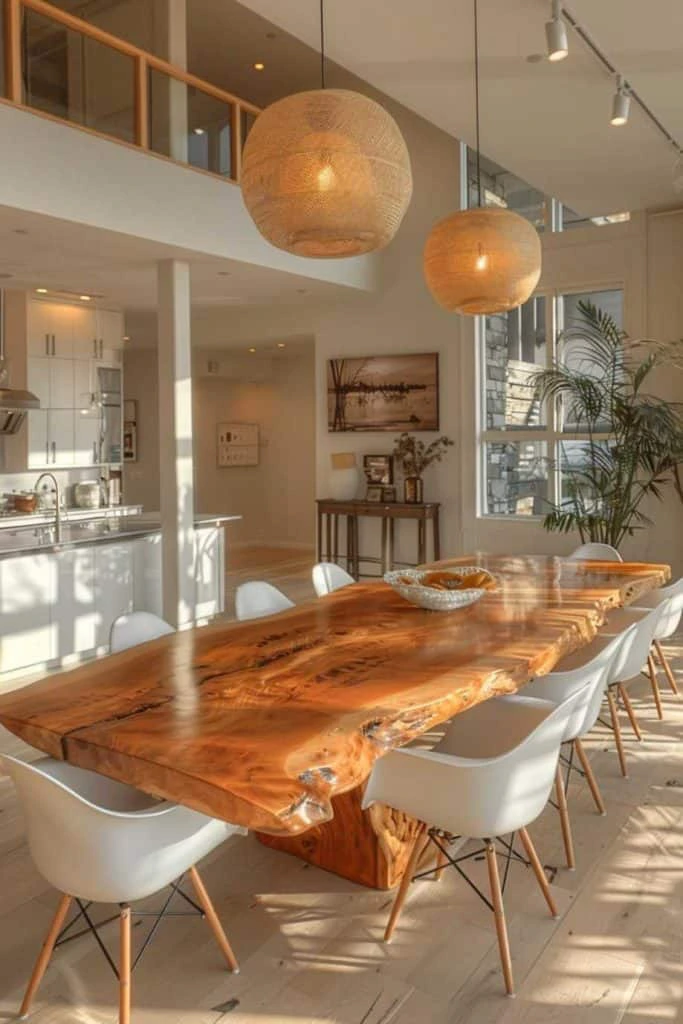You weren’t meant to live in a box.
You were meant to breathe, bloom, and feel at home with the natural world—even indoors.
But somewhere along the way, modern life forgot that.
Dull walls. Processed air. Artificial light. Stress and disconnection disguised as convenience.
It’s no wonder people are craving more than “aesthetic”.
They’re craving alignment.
Enter the rising power of Sustainable Interior Design and Biophilic Design—not as trends, but as a return to what we know deep down:
A lovely space should also be a healing one.
And the best design doesn’t just serve the eye—it serves the soul.
What is Sustainable Interior Design?
Sustainable design isn’t just using a bamboo tray and calling it a day.
It’s about creating spaces that work in harmony with the planet—and with the rhythms of your life.
Key pillars include:
- Eco-friendly materials like reclaimed wood, cork, organic cotton, and low-VOC paints that keep toxins out of your home and landfills.
- Energy efficiency through LED lighting, smart thermostats, and appliances that reduce waste without compromising elegance.
- Waste-conscious furnishings with modular pieces, upcycled treasures, and timeless craftsmanship that lasts.
True sustainable interior design asks not just, “How does this look?“
But, what impact does this leave on you and the world?”
What is Biophilic Design—and Why You Need It
Biophilic design is more than adding a few plants.
It’s about integrating the indoor world intentionally, beautifully, and holistically into the natural world.
Biophilic design principles include:
- Natural light that supports your circadian rhythm and boosts your mood.
- Indoor greenery that purifies air and quiets the nervous system.
- Nature-inspired textures and patterns that mimic the calming flow of wood, water, and stone.
- Views and sensory cues that invite you to feel present, rooted, and alive.
It’s a design philosophy grounded in science and how humans are biologically wired to thrive.
When Sustainability and Biophilia Work Together, Something Powerful Happens
We design not just for beauty, but for benefit.
When sustainable interior design fuses with biophilic design, the result is something rare:
- A home that uses less—but gives more.
- A space that looks stunning and also lowers anxiety.
- Rooms that reduce energy bills and increase your sense of peace.
This isn’t luxury. This is life done well.
What This Looks Like in Real Homes
In Living Rooms: Reclaimed wood shelving meets organic fabrics and oversized windows framing wild garden views.
In Kitchens: Recycled countertops, low-energy appliances, and herb walls that nourish more than just your meals.
In Offices: Mycelium acoustic panels. Standing desks are made from FSC-certified wood. Lighting that changes with the sun.
In Bedrooms: Linen sheets. Plant-filtered air. Silence.
Because every room should feel like it’s rooting for you.
Health Benefits You Can Feel (and prove)
Science backs it all:
- Lower cortisol (stress hormone) levels
- Improved sleep
- Boosted productivity
- Fewer sick days
- Better emotional regulation
Your environment doesn’t just influence your aesthetic—it shapes your biology.
Expert-Level Tactics You Haven't Seen Everywhere
These underutilized strategies elevate your home from good to life-altering:
- Bio-Based Acoustic Panels:
Made from hemp, cork, or mycelium, they improve sound and sustainability in one move. - Regenerative Flooring:
Cork and bamboo grow back faster than they’re harvested—they act as carbon sinks. - Dynamic Natural Stimuli:
Moving light. Indoor gardens. Water elements. Create emotional shifts that mirror real life and build a deeper connection to your space.
Why This Matters More Than Ever
This isn’t about decor.
This is about defense against burnout, digital fatigue, and emotional numbness.
It’s about designing a space that brings you back to yourself.
And it’s about leaving behind spaces that don’t just last, but give back.
Because the best design doesn’t age—it evolves with you.
Work With a Designer Who Understands the Deeper Why
At Spaces by JohnRoss, we don’t just add plants and call it Biophilia.
We don’t slap on bamboo and call it Sustainable.
We go deeper.
We study how you live, what grounds you, what overstimulates you, and what brings you joy.
Then we design from there with sustainable materials, sensory intelligence, and soul.
Ready to Build a Space That Restores You?
Spaces by JohnRoss:
Where sustainability meets sanctuary.
Where design makes you feel human again.
What's the difference between sustainable design and green design?
Green design is often surface-level. Sustainable design considers the entire lifecycle—from source to soul to future impact.
Can I use biophilic design in a small apartment?
Absolutely. Even one window, one plant, and one natural texture can change the energy of your space.
Is sustainable interior design expensive?
Not when it provides longevity, lower energy costs, and reduced health issues. It’s an investment that pays you back.
How do indoor plants improve air quality?
They absorb toxins, increase humidity, and lower dust, while enhancing mood and reducing stress.
What's a simple way to start?
Switch to LED lighting. Use low-VOC paint. Add one plant you’ll love. Every small choice adds up.



1 Comment
Pingback:Is Sustainable Design Expensive? Here’s the Real Cost| Spaces by JohnRoss
Posted at 04:53h, 16 July[…] • Sustainable Interior Design Meets Biophilic Living: The Future of Spaces That Heal […]